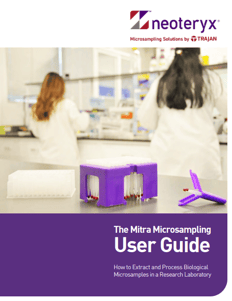microsampling in scientific research
Discover Mitra® devices with VAMS® technology and the hemaPEN® – advanced microsampling tools for precise, remote blood sampling in clinical research, public health surveys, and epidemiology studies.
Revolutionize Research with Remote Microsampling
Are you seeking an efficient solution for your clinical research studies? Look no further!
Our Mitra® and hemaPEN® devices offer volumetrically precise remote specimen collection for high-quality samples that help you generate accurate data.
These devices help researchers adopt a volumetric sampling approach, solving many of the limitations encountered with traditional dried blood spot (DBS) technology. Optimize your bioanalytical capabilities today!
Frequently Asked Questions (FAQs)
Yes, our microsampling devices with volumetric technology have been used in research studies around the world. Our Technical Resource Library includes a searchable selection of published literature discussing research studies and trials with both adult and pediatric study participants. Type your analyte of interest in the library's search field to find journal articles, presentations and application notes from third-party research groups.
Our Technical Resource Library provides information on the types of analytes that have been evaluated by researchers using the hemaPEN® and Mitra® devices with VAMS® technology. Type your analyte of interest in our Technical Resource Library search field to find the information you seek.
With proper use, sample success rates can be quite high for Mitra® and hemaPEN® devices, which are based on volumetric microsampling.
The absorptive VAMS® tips on Mitra can absorb homogenous samples with 99% acceptance rates.* By following the illustrated instructions and demo videos available with hemaPEN and Mitra, end-users can reliably collect fixed volume samples that are precise enough for lab analysis.
These volumetric microsampling devices overcome the hematocrit (HCT) bias that may occur with DBS cards, where non-homogenous blood spots on filter paper have higher variability and higher failure rates.
*Data on sample success rates are discussed in published research articles in our online Microsampling Resource Library.
Example: https://www.medrxiv.org/content/10.1101/2021.01.27.21250570v1.full
Published research papers show that dried capillary whole blood microsamples collected in 10, 20, or 30 µL volumes are enough for good extraction and analysis. These samples also yield high-quality data that are similar to data from venous blood. The literature provides case examples of microsampling in research applications. Visit the Technical Resource Library to review many comparative studies that describe what others have achieved with microsampling in their research.
Dried blood sampling (e.g., using Mitra® devices, hemaPEN® devices or DBS cards) can eliminate the requirement & expense of a certified professional to perform the blood sample collection. In addition, the transport of dried blood samples to a central laboratory doesn’t require costly cold-chain shipping supplies/methods, but instead can be shipped via standard post.
 Microsampling User Guide
Microsampling User Guide
This technical user guide is designed to get you started with microsampling. The printed guidance from our technical director helps you make initial decisions on best practices for achieving solid analytical validations in your research projects. What microsample volume is needed for your assay? What analyte classes are compatible with microsampling? How do you process microsamples in the lab? Download the guide to find answers to these questions, and more!
Research Blog Listing
Read from a selection of blogs to learn about all the different ways that remote microsampling is being applied in public health studies, epidemiology research, and related programs. Click the button below to explore our blogs on microsampling research, gathered together in a single listing.
Microsampling in Research: Interview
We spoke with Jennifer Van Eyk, PhD, a Professor of Medicine at Cedars-Sinai Medical Center, who directs the Advanced Clinical Biosystems Research Institute, the Precision Biomarker Laboratory, and Basic Research Science in the Barbra Streisand Women's Heart Center. She also co-directs Cedars-Sinai Precision Health. Dr. Van Eyk discusses her research on high throughput quantitative proteomics and disease-induced biomarker studies. The Van Eyk Laboratory at Cedars-Sinai is interested in the molecular basis behind a range of cardiovascular disorders.
Gain Access to the Microsampling Resource Library!
How do others use microsampling in research studies? For answers, fill out the form to gain access to our Microsampling Resource Library, where you can find materials by selecting either the resource type, key topic, assay or by typing your topic of interest in the general search field.


